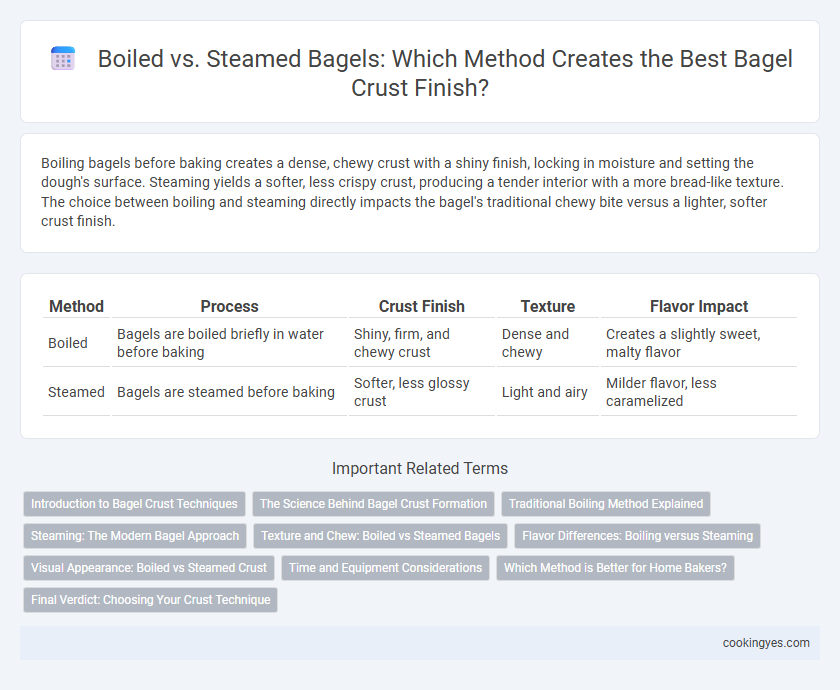Boiling bagels before baking creates a dense, chewy crust with a shiny finish, locking in moisture and setting the dough's surface. Steaming yields a softer, less crispy crust, producing a tender interior with a more bread-like texture. The choice between boiling and steaming directly impacts the bagel's traditional chewy bite versus a lighter, softer crust finish.
Table of Comparison
| Method | Process | Crust Finish | Texture | Flavor Impact |
|---|---|---|---|---|
| Boiled | Bagels are boiled briefly in water before baking | Shiny, firm, and chewy crust | Dense and chewy | Creates a slightly sweet, malty flavor |
| Steamed | Bagels are steamed before baking | Softer, less glossy crust | Light and airy | Milder flavor, less caramelized |
Introduction to Bagel Crust Techniques
Boiling bagels before baking creates a dense, chewy crust with a shiny finish by gelatinizing the starch on the surface, which locks in moisture and controls expansion. Steaming bagels, less traditional, produces a softer, less chewy crust with a lighter texture, as steam prevents crust hardening and retains surface moisture. Understanding these techniques highlights how water-based treatments affect the bagel's final texture and appearance, catering to different preferences in crust finish.
The Science Behind Bagel Crust Formation
Boiling bagels gelatinizes the starches on the surface, creating a dense, chewy crust with a shiny finish that locks in moisture during baking. Steaming introduces steam heat that softens the crust's exterior, resulting in a lighter, less chewy texture with a subtle sheen. The Maillard reaction accelerates on boiled bagels due to the altered surface starch structure, enhancing browning and flavor complexity.
Traditional Boiling Method Explained
The traditional boiling method for bagel crust involves briefly submerging shaped dough in boiling water, which gelatinizes the starches on the surface, creating a dense and chewy outer layer. This process locks in moisture and produces the characteristic glossy, crisp crust that differentiates authentic bagels from steamed varieties. Unlike steaming, boiling also contributes to the unique flavor development and the iconic bagel texture prized in New York-style bagels.
Steaming: The Modern Bagel Approach
Steaming creates a softer, more delicate bagel crust by gently cooking the dough's surface, preserving moisture and enhancing chewiness compared to traditional boiling. This modern method allows for consistent crust texture and a slightly glossy finish without the dense, chewy exterior typical of boiled bagels. Steam also facilitates better expansion and airy crumb structure, appealing to contemporary palates seeking a lighter bagel experience.
Texture and Chew: Boiled vs Steamed Bagels
Boiled bagels develop a dense, chewy crust with a glossy finish due to the rapid gelatinization of starch on the surface, creating a signature firm texture and distinctive bite. Steamed bagels, by contrast, yield a softer, less dense crust with a tender texture but lack the characteristic chewiness and glaze that boiling imparts. The boiling process enhances crust thickness and strength, resulting in the traditional bagel mouthfeel preferred in classic recipes.
Flavor Differences: Boiling versus Steaming
Boiling bagels creates a thick, chewy crust with a slightly crispy texture and a subtle, malty flavor from the Maillard reaction during baking. Steaming produces a softer, tender crust with less browning, resulting in a milder, doughier taste that highlights the bagel's interior flavors. Flavor differences between boiled and steamed bagels are evident in crust texture and toasty notes, with boiling intensifying the traditional robust bagel character.
Visual Appearance: Boiled vs Steamed Crust
Boiled bagels develop a shiny, smooth crust with a distinctive deep brown color due to caramelization during boiling, creating a classic, glossy finish. Steamed bagels exhibit a softer, matte exterior with a lighter, less uniform color, resulting in a less traditional appearance. The boiling process enhances crust thickness and sheen, while steaming produces a tender, pale crust without the characteristic shine.
Time and Equipment Considerations
Boiling bagels typically requires a large pot of rapidly boiling water and only takes about 30 to 60 seconds per batch, which can limit production speed but ensures a chewy crust. Steaming bagels demands a steam oven or specialized steaming apparatus, extending the process to around 10 minutes per batch, producing a softer crust with less chewiness. Time efficiency and available equipment heavily influence whether boiling or steaming is preferred in commercial or artisanal bagel baking.
Which Method is Better for Home Bakers?
Boiling bagels before baking creates a denser, chewier crust with a glossy finish that is traditional and authentic, making it a preferred method for home bakers seeking classic texture. Steaming, while less common, produces a softer, less chewy crust with a slightly lighter texture but lacks the characteristic chewiness that defines a bagel. For home bakers aiming for the iconic bagel crust, boiling remains the superior technique due to its proven ability to develop the ideal chewy exterior and shiny crust.
Final Verdict: Choosing Your Crust Technique
Boiling bagels produces a chewy, shiny crust with a distinctive bite, ideal for traditional New York-style bagels, while steaming yields a softer, slightly thicker crust preferred in some European varieties. The choice depends on texture preference and desired crust firmness; boiling enhances crust chewiness and gloss, whereas steaming results in a tender, less crunchy finish. For authentic bagel craftsmanship, boiling remains the favored technique to achieve the classic crust finish.
Boiled vs steamed for bagel crust finish Infographic

 cookingyes.com
cookingyes.com